Luther Rix, Rolling Thunder's Elusive Percussionist, Speaks
1975-11-29, Coliseum, Quebec City, Canada
Flagging Down the Double E’s is an email newsletter exploring Dylan shows of yesteryear. I’m currently writing about every show on the Rolling Thunder Revue. If you found this article online or someone forwarded you the email, subscribe here to get a new entry delivered to your inbox every week:
Update June 2023: This interview is included along with 40+ others in my new book ‘Pledging My Time: Conversations with Bob Dylan Band Members.’ Buy it in hardcover, paperback, or ebook here!
Scarlet Rivera always gets called “mysterious,” but, to me, the most mysterious Rolling Thunder band member is percussionist Luther Rix. He was a core member of the Rolling Thunder band for the entire 1975 tour, but there’s relatively little information out there about his role.
That’s partly because, by virtue of being a percussionist playing alongside a drummer (Howie Wyeth), it’s difficult on the tapes to pinpoint Luther’s exact parts – except the unmistakable congas on “Hurricane,” that is. It’s partly that he doesn’t appear in Renaldo and Clara except occasionally in the shadowy back of the stage. And it’s partly that, by his own admission, he’s not much of a self-promoter.
But Luther was nice enough to take some time a few weeks back to answer my questions, both about his role on Rolling Thunder and his career overall. Thanks to Rob Stoner for connecting us.
What was your career like before Rolling Thunder?
When I was a teenager, I was a cello student and a good one. My teacher was in the Washington National Symphony, and his teacher, Fritz Magg, was teaching at Indiana University, so I went there as a cello major. At that time, believe it or not, it was the world's largest music school. I didn't last very long. After I think one semester, I changed my major to percussion. I was in the Midwest for a little while, played a lot of jazz and two seasons with the Indianapolis Symphony.
Then I moved to New York and got into rock and roll. I was with a band which at the time was one of the big psychedelic bands on the East Coast, The Group Image. I played with another band that was quite big in New York for a while called Ten Wheel Drive with Genya Ravan. It's another one of those things that was a real hot prospect that didn't really pan out, but it was fun for a while.
I had some folk-rock background [too]. Before I went on Rolling Thunder, I played with Mary Travers from Peter, Paul, and Mary for quite a while. I met Rob Stoner along the way, played with him occasionally with his own thing.
As you probably know, the Rolling Thunder band began gathering momentum like a rolling snowball. Bob would go around to clubs in the Village and hear people play and stuff and ask them if they wanted to do a tour, and they all started going around with him, and pretty soon they had a band.
I wasn't in that whole process of getting to go around and have a good time at the clubs. I was the only one that was called up by Rob and asked if I wanted to do the tour. Hired like a regular musician. They [had] picked a percussionist who didn't work out. Apparently, he was too much of a hardcore Latin percussionist and had a hard time fitting in with the folk-rock thing. I just got called up and hired for the gig because the other guy didn't work out.
It wasn't hard for me to find things to do with congas and Latin toys because I was, basically, a rock and roll drummer who had played a lot of that kind of music on the drums and on percussion. I also played with Buzzy Linhart, another folk-rock guy who was real hot at the time. When I started with him, it was just the two of us and I played congas and other stuff. I had a lot of background in that stuff, so I slid right into the groove.
You were first hired to play congas on “Hurricane”on the Desire album.
Sure. I didn't play on most of the cuts. In fact, I think that Hurricane may have been the only one I actually recorded on. I got to play congas on that, and they were right up front, which pleased the heck out of me.
What do you remember about that recording session?
It was like a typical Bob Dylan session from what I came to find out, in that Bob picked a take strictly in terms of which vocal rendition he liked the best, and that was the one. It was a common attitude in the folk world, at least in those days. Doesn't matter if there's mistakes or whatever. As far as the actual recording session, I just remember that I was there, and I made up a part, and it turned out to work pretty well.
Do you remember if you were given instructions, "I'm looking for this or that," or did you just sit down and wing it?
I was standing up and winging it. I had a stand for the congas - but I was definitely winging it. We did a few run-throughs, and I got to learn the tune and see what Howie was playing and all that.
When plans for the tour got underway, what do you remember about the rehearsals?
It was pretty loose. The typical thing at rehearsals was, if Bob had a suggestion, he'd whisper something in Rob's ear, and Rob would turn around to the band and say, "Bob said--" [laughs] I had a hard time getting used to that. I wanted to say, "Hey man, Bob's right there!" But that was the way it was.
I noticed as time went by that all anybody had to do was walk in the room and go, "Bob says…" and everybody would go, "Okay, what, what, what?" If you said, "Bob says we're all going to go out and take a dump in the snow," people would head to the exits pulling their pants down.
I thought that Bob was a pretty cool guy. I didn't get to hang with him much, but once in a while he'd come over and talk to me for a few minutes. I think he felt like he ought to, especially because we hadn't really had a chance to get to know each other. A nice enough guy.
I remember one time, as the tour was winding up, I said to him, "I'm really looking forward to getting back and sleeping in my own house.” He looked at me like, "What?" Like he was just dumbfounded. Such a thing had never occurred to him. I think that's who he was, and maybe still is. His real home was being on the road with the band. That was it for him, whereas I had two or three modes that I was equally satisfied with, one of which was just being in my house.
What was life like on the road?
They were deliberately staying at New England resort hotels in the offseason. We'd go stay at some hotel, and there would never be anybody there. They would just open up some rooms for us and open up the kitchen. Every place we stayed, it was deserted except for the band.
Bob probably loved that.
I liked it too. What can I say? You go to the bar, and there's nobody there but you. You get a drink right away.
You are always listed as percussionist, and that's one of those words that can mean a whole bunch of things. What were you actually playing?
I had a bunch of stuff up there. Congas was my main instrument, but there were tunes where I didn't play conga at all. Maybe I just played a shaker, or I would play tambourine with one hand and hit the backbeats on the congas with my other hand, that kind of stuff. I had, I think, two cymbals, both of which I could crash with a hand if I needed to. They were pretty thin cymbals, very crashable.
Were you on stage for all the songs? Again, it's hard to hear in the audio who's playing what between you and Howie.
When I watched the movie, I noticed there were some cymbal crash accents when I was staring right at Howie on the screen, and he was definitely not playing them. So my part was coming through most of the time.
I don't remember whether I actually played on every tune. I never had a chance to go out in the audience and see things from the front. If I had, maybe I would have suggested that they position the camera a little differently so you could see those of us over on the side. I only found that out later.
One of the great things, for me about seeing the [Scorsese] movie was I could actually see what the show looked like, and especially get to see Bob sing. That was very emotional for me. And to watch Stoner---actually, pretty much anybody who was singing with Bob, watch them channel Bob like a psychic or something. The same expression on their face even, not to mention the same vocal inflections and stuff. Stoner was the best at cloning Bob. That was fascinating to me. It's great for me to see the movie, except for the parts that I didn't understand, like Sharon Stone mystically appearing on the tour.
One of the great parts in the movie that is not made up was that mahjong performance where it's you and Bob right before the tour kicks off playing for a bunch of old ladies. Do you remember that?
I do, I do. That was a real odd event. You have to adjust your playing volume, for sure, when it's just you and a piano, but it sounds pretty good actually. It came off pretty well. The old ladies looked amused, and maybe slightly puzzled. I thought we were a hit. Ginsberg also read from one of his famous poems. Some of it was really, really obscene; it made me uncomfortable, I can only imagine what the old ladies were thinking.
Was that just the sort of thing that would happen on the road, these spontaneous, semi-random happenings?
I'll tell you the truth. My wife Ellen was with me on the tour. We were newly married and I wouldn't go on the road unless Ellen came with me. We were a little older than a lot of the people on the tour. The hysterical party atmosphere on the band bus was a little too much for us. After a while, we decided to ride on the crew bus where things were much more calm.
We weren’t perhaps as social as a lot of people. Like when they went to the Indian Reservation, Ellen and I just took the day off. We talked to Joni Mitchell about it later on, and she said, "Yes, it was pretty weird. When we ate dinner, we were at the long table up at the front of the sanctuary, and the Indians were all sitting there staring at us, we looked like a painting of the Last Supper.”
Was that typically your attitude towards all the filming, the extracurricular stuff, that you and Ellen would just bag it and do your own thing?
Yes. Honestly, I was glad to have some time away from the tour, like a day off. So everybody else would be going out filming Renaldo and Clara, and I would be laying back. I wasn't in the movie and I'm not sorry about that. I'm not a fan of the movie at all. I think it's just awful. [laughs]
Did you get along with Howie Wyeth? I would imagine you two had to work together pretty closely on this stuff.
Sure. We didn't discuss the music a lot because, groove-wise, it wasn't all that complicated. I let Howie take the lead as far as what the basics were going to be. I let him keep the time. The drummer's the number one guy. I would try to find ways to complement that.
Generally, if there's another drummer, how do you find ways to fit yourself in?
Well, for one thing, Latin music is a little different from American music. You would never hear an American percussionist say, "This is this kind of an instrument, and this is what you play on this instrument." "Wait a minute. [laughs] I'm going to play that all the time?" In Latin music, there's a large degree of truth in that. You can say, "This is the conga, and this is what the congas do.”
American music is not like that, but when you're playing congas, you have a tendency to go the conga route. Plus Howie's right there playing what he's playing. I'm going to play something that goes with that. I might not duplicate his rhythm, but I know what to play around that to make it sound good. If there's big rhythmic accents in the tune, I hear what Howie's doing with them, and once again, I can go right with it and re-emphasize the way he is, or I can set up what he's playing. If you’re familiar with the instruments and the style of music, it’s not really a problem.
Were there any particular songs you remember enjoying playing?
The hard-charging ones were always fun to play. “Hurricane” was always fun. “One More Cup of Coffee.” God, what a great song. There're a couple of things that Howie went over and played piano on, because he was a good piano player. I would step over and play the drums.
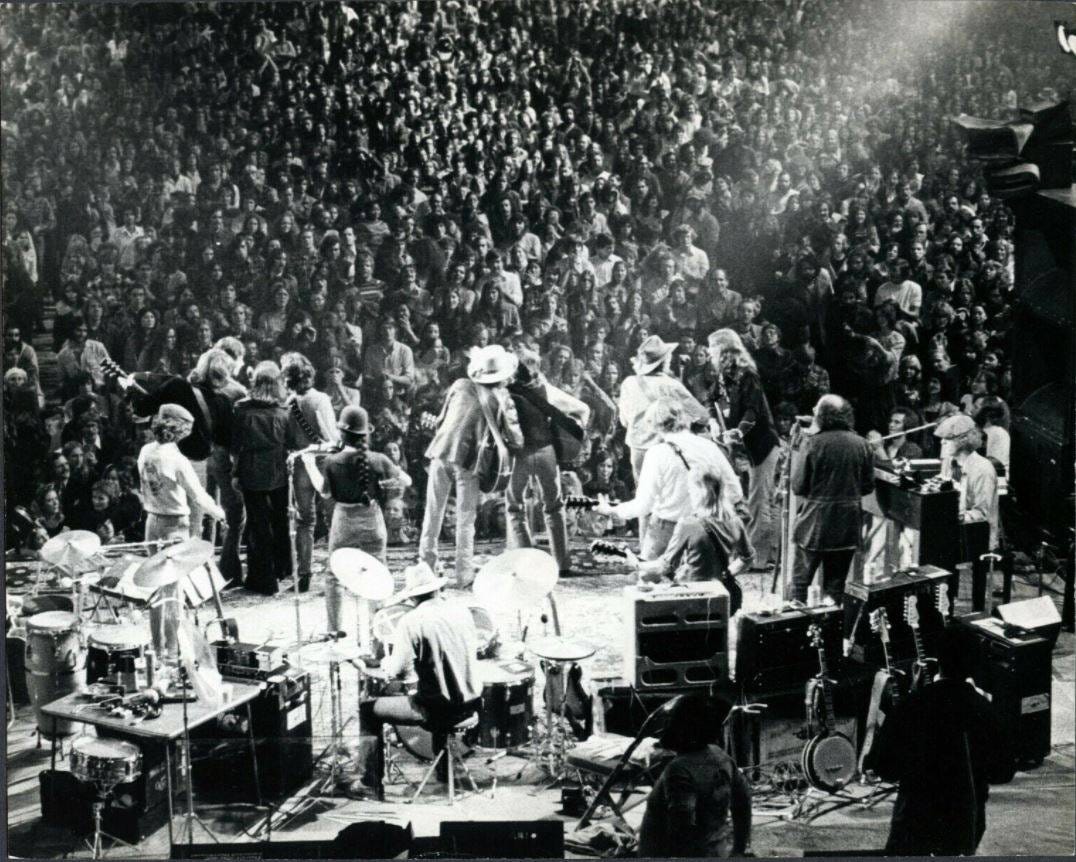
You knew Rob already and we've talked about Howie. Were there any other members of the band or the touring crew that you got along particularly well with?
I got along with pretty much everybody. Joan Baez once told me I couldn't smoke my cigar on the train. At the time, I remember I got a little pissed off, but she was right, of course.
Allen Ginsberg was a hoot. Quite a character. One time I had a headache and he asked me to tell him where the headache was. I pointed and he said, "I want to massage your eyeballs," and I said okay, because that's the kind of guy he was. You trusted him to know what he was doing and have his heart in the right place. He did it, and he knew just what to do. It really worked.
I’m sure the shows mostly blend together, but do you have any memories of particular shows or particular towns or cities along the way?
We played on an ice hockey rink once, that was cold. They had seats on the ice. [laughs] I am not making this up. And the Astrodome thing [in Jan ‘76], that was a hoot, Ringo was there, and Dr. John, and Stevie Wonder with his band. Not a great place for sound, but it's huge and it's round, what can you do?
Did you interact with Ringo at all? I would've imagined for a drummer, that one would jump out.
I was not the guy to seek people out and say, "Hey, can I get a selfie?” Not that they had selfies in those days, but I was pretty laid-back. You might've gotten that drift.
Speaking of laid-back, I read in the Sam Shepard’s book that you meditated before every show.
I probably did. I was into meditation at the time. When I was with Leonard Cohen, after a while I realized that meditation was making me feel good, and feel satisfied, and all that great-sounding stuff, but I had also lost the ambition to do anything new. I wasn't writing, I wasn't practicing, everything seemed okay.
You were too tranquil?
Exactly right. I was all but smug. I just said, "I got to get some of my edge back. I want to be dissatisfied.” But on the Dylan tour, I was still satisfied.
You said you did that one-off show in Houston, but why didn't you end up returning for the full second leg in '76?
I got some other offers. The idea of touring all over Northern Europe with Leonard Cohen sounded like something we really would have fun doing, and we did. Neither one of us had ever been to Europe, and the second Rolling Thunder tour would've been something we had done already. It wasn't nothing about not wanting to do another tour with Bob.
You might have dodged a bullet on the '76 tour. Pretty much everyone says that the vibe wasn't as good.
Yes, I didn't hear anybody saying, "Oh God, you really missed out, Luther." It was one of those lucky choices for me.
Was the Leonard tour as good as you'd hoped it would be?
Better than I imagined, I swear to God. Leonard was great to work for, never a harsh word, never a problem. He lived for hecklers. He could outsmart them and come up with a wisecrack that would crack the audience up and diffuse everything immediately. Fun guy to work for.
Did you just do the one tour with him or did you keep on?
Just the one. The guy that called me for the gig, the musical director, didn't get called back for the next tour, so I didn't either. Leonard had no band loyalty in those years, I don't think. Once the tour was over, I called him a couple of times. He didn't even answer my calls. But I'm sure if I had run into him on the street, he would've been very friendly and affable. He is who he is.
After Rolling Thunder and after Leonard Cohen, just to finish up the biography, what were some of your big gigs in the coming years and, I guess, decades?
I did a lot of Broadway shows. The only one that was a big hit was TheWho's Tommy on Broadway [in the ‘90s]. It was a bunch of New York rock musicians. The Tommy album was only like, what, 45 minutes or something. They expanded the story and stretched it out into a Broadway show. It was quite a hit at the time.
How was it trying to translate Keith Moon drum parts?
Well, you couldn't be as drunk and stoned as Keith Moon and do a Broadway show! There's choreography to what you're doing, so you can't get too loose. But I didn't play exactly the same thing every night; I tried to keep a little Keith Moon spirit in it.
I also had the first offer to do Annie on Broadway when it came out [in 1977], but at that time, I was like, "Broadway shows? Who wants to go play the same thing every night?" I didn't do that one. I also had an offer to play with Carly Simon at one time, another one of my historic turn downs. When I played drums with Bette Midler, Barry Manilow was her musical director. Barry asked me to go on the road, but we'd just gotten done with six months with Bette and I was not ready.
Do you do many interviews like this? I was trying to research you, and my impression is maybe you don't promote the Rolling Thunder thing as much as some of the other people.
I haven't had to. Especially after my son was born, I just hardly went on the road at all. I had a very respectable career in the New York studios for a while. I recorded over 1,000 jingles, commercial songs, and played on various people's albums from time to time. As you may have guessed, I was never that much of a self-promoter.
Thanks to Luther for taking the time to chat! He also sent me some great photos from the band’s bus that I’ve never seen before:
Update June 2023:
Buy my book Pledging My Time: Conversations with Bob Dylan Band Members, containing this interview and dozens more, here!
Rolling Thunder XX: Quebec City
The Venue
The Quebec City Coliseum is now the Colisée Pepsi; even French Canada is not immune to corporate name-changes. And, as exotic as Quebec City sounds, it looks like a pretty generic arena. An old one, though, setlist.fm lists shows going back to the early 1950s (Duke Ellington!). As of last October, it was scheduled to be torn down this year, but I don't know how the pandemic has affected those plans.
Show/Setlist Changes
Rolling Thunder goes French! Joan leads the Francophile charge, supposedly singing "Can't Help Falling in Love" in French (no recording, unfortunately) and introducing some songs in French, including her duets with Bob. I imagine that reported "Can't Help" in French was actually the 18th century French song "Plaisir D'Amour," on which the melody of the Elvis hit was based. Joan had been singing that since the 1960s:
Bob's French contributions are more minimum, with one big exception: That great moment where Bob and Joan sing part of the "Blowin' in the Wind" choruses in French. They'd do it more famously in Montreal a few nights later - that tape was released on the box set last year - but it started tonight in Quebec City.
Onstage Comments
Before "Lonesome Death": “I don’t speak much French myself, wanna dedicate this song to the great French poet Arthur Rimbaud.”
Contemporary Reviews
Here's a review from Bob himself, as told to Ratso later: “They didn’t understand a word, but they loved it… I could tell, anybody could tell. Quebec City was the nicest place I’ve seen, I can’t figure it out.”
Here’s Ratso’s own take:
“Once again, tonight seems to be Baez’s show, mainly because of the language barrier that forces the audience to respond to timbre and melody rather than lyrical forcefulness. Dylan tries by dedicating a song to Rimbaud, prefacing the dedication by saying, ‘I don’t speak too much French myself.’
Baez, though, connects from the outset with ‘Diamonds and Rust,’ which draws lusty cheers that get matched when she plows into ‘I Can’t Help Falling in Love’ in French, followed by ‘Joe Hill’ dedicated ‘how you say, pour les pauvres du monde.’ But Dylan finally scores with the familiar ‘Just Like a Woman’ and the upbeat Guthrie ending rouses the audience into a standing ovation. One that was hard-earned.” - Larry "Ratso" Sloman, On the Road with Bob Dylan
What'd they do before the show?
Cross the border! In a blizzard, no less.
Renaldo & Clara footage
They filmed an energetic "House of the Rising Sun" in Ratso's hotel room. It's filmed pretty close-up (starts around 2:30:45), so you don't see the, shall we say, atmosphere, the crew created. Per Ratso's book again:
By the time he returns to his room, the crew has made it almost unrecognizable. The beds have been moved apart, equipment is all over the room, his clothes are all strewn in one limp heap in the corner, and, indignity of indignities, all the French pornography that Ratso picked up at a little candy store just north of the border is now hanging lasciviously from every available wall, mirror, drape, and painting. Ratso just mumbles to himself, hops on top of a dresser, just below a torrid lesbian dildo scene, and whips out his notebook.
Also not in the movie: The hotel manager storming up to shut them down, saying they're making too much noise.
What's on the tape?
Most of the Dylan set- it starts partway through "It Ain't Me Babe" and cuts of some of "This Land Is Your Land." The taper also captured a few Baez song, though, sadly, not the one(s?) in French.
1975-11-29, Coliseum, Quebec City, Canada
Find the index to all shows covered so far here. Subscribe to get future newsletters delivered straight to your inbox here:
BUY MY NEW 33 1/3 BOOK 'I'M YOUR FAN: THE SONGS OF LEONARD COHEN':
Bloomsbury | Amazon | IndieBound | Barnes and Noble | Bookshop
*** More info on the book here… ***

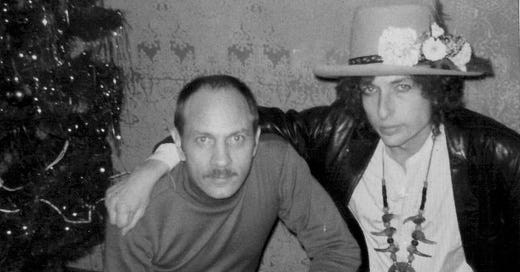


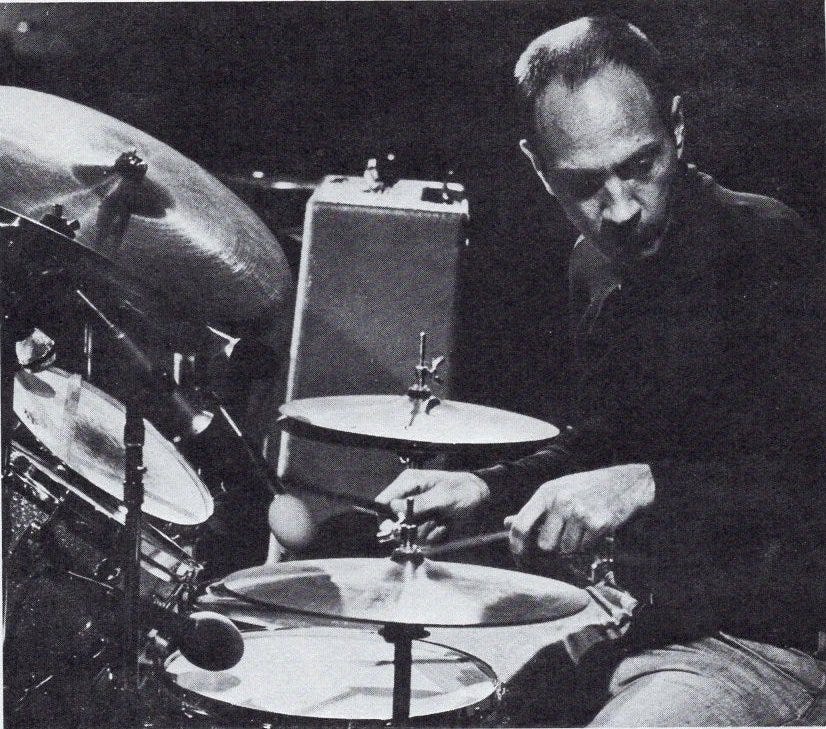
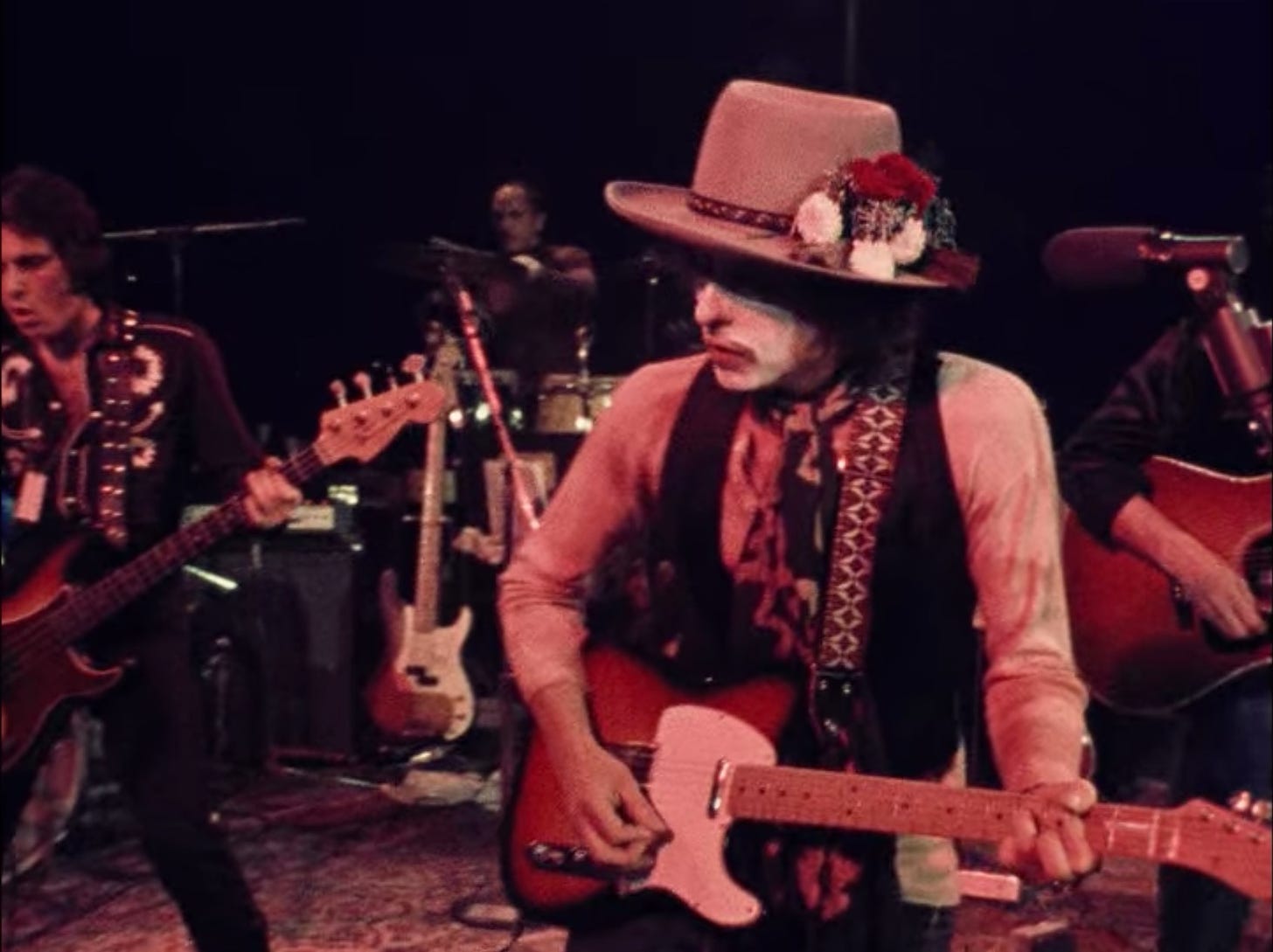

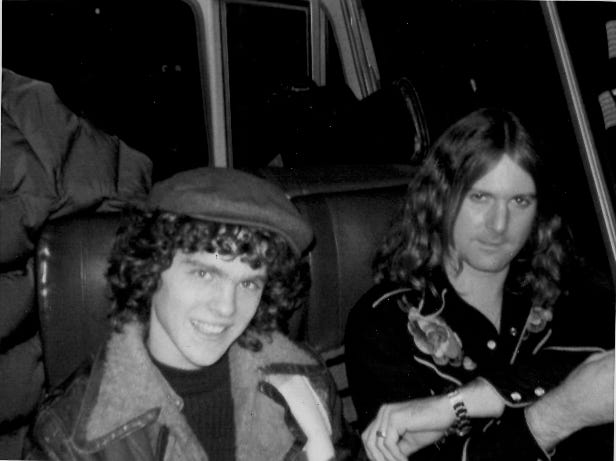

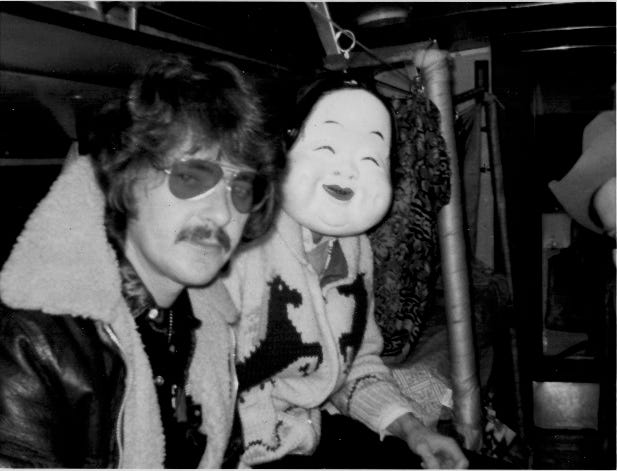
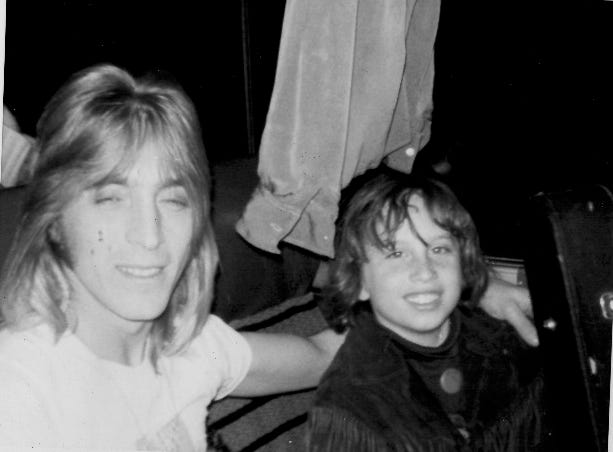

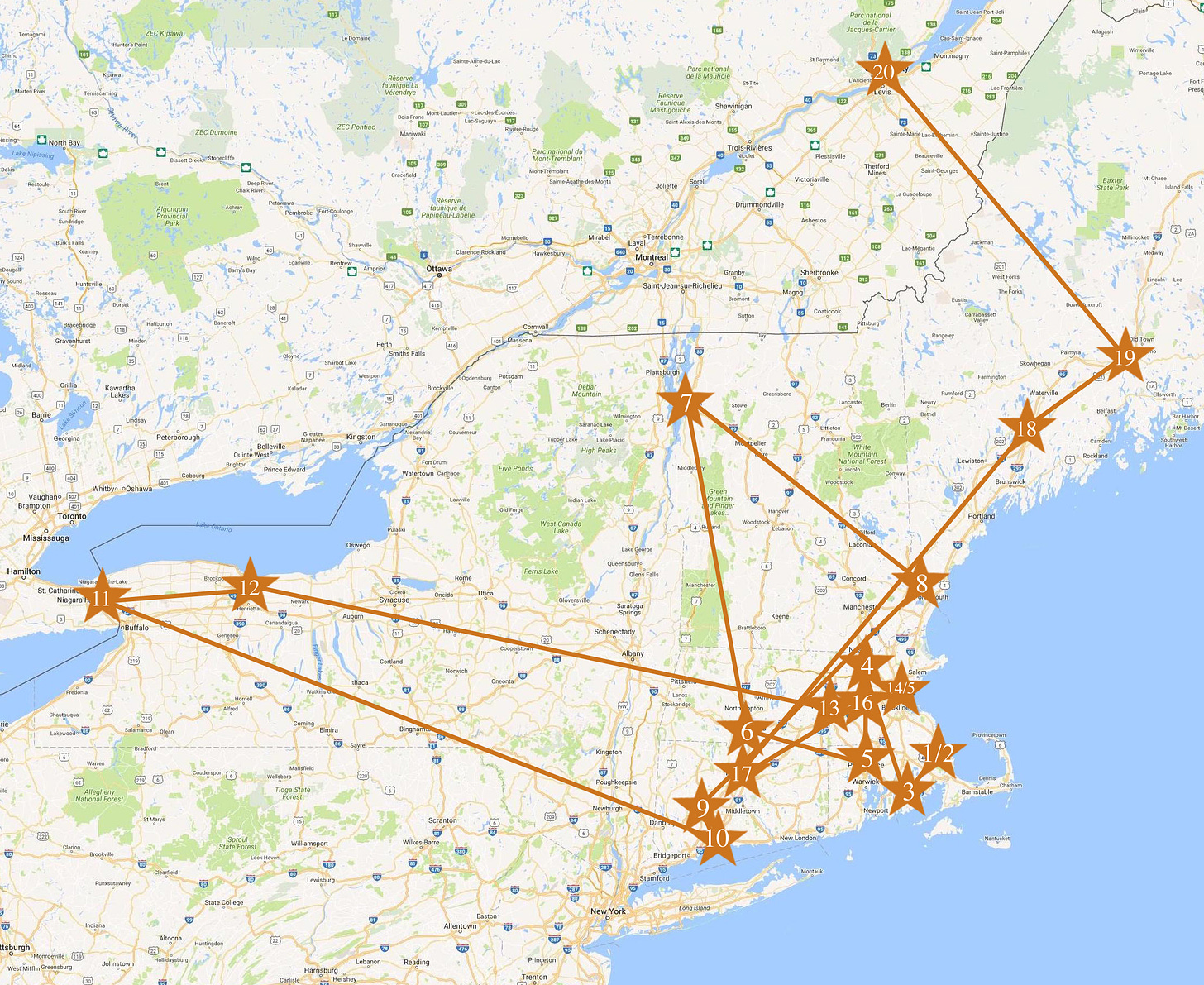
[man, I hope he doesn’t get mad at me for this…] Great interview! My favorite Luther story is actually when he met Ellen backstage after a Bette Midler show: He & Bette shared a romantic past but had settled by this point as just very good friends and occasional bandmates. Yet… still… the appearance of Ellen standing behind her friend in the dressing room doorway, eyes timelessly locked with Luther’s who had just glanced up to be instantly transfixed, made her instinctively create with outstretched legs the unmistakable likeness of a barrier by placing her bare feet square in his lap, as if to say: “Mine!”…… But yeah, that didn’t work - Luther & Ellen tied the knot mere months later and to this day share one of my favorite marriages ever.
Wonderful...👏